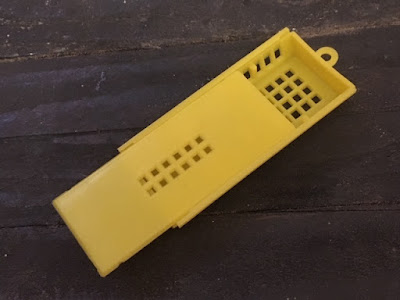The first time that I attempted such an introduction was with an AMM queen that I had acquired in-order to evaluate and hoped that she would push forward my progress to breed British Native bees. I made up a nucleus colony of two frames of bees plus stores and introduced the queen in a queen introduction cage. I plugged the exit with candy to delay the release of the queen as is suggested and suspended the cage between the two brood frames. On inspection two days later the cage was empty, the queen having been released, happy days!
 |
| Queen cage |
However, the following day I found a very sick looking queen on the ground below the entrance to the hive, she was easy to spot as she was marked. The only thing that I could think of to do was to place her back into the cage, with another plug of candy and try again. I checked for any queen cells and found none. Fingers crossed, this time she would be accepted.
No such luck I found her outside the hive three days later, this time she was dead.
If I was going to invest in new queens I needed to find a more reliable way to introduce them into a colony. I searched the web and found a number of pages referring to "push in cages", beekeeping suppliers such as Thornes stock these items (Link) but they are easy to make yourself and they will probably be better ......
They can be made from woven steel mesh (size: 8 mesh). , I found that this supplier (Link) offered "samples" in a size (Large Sample 300mm x 200mm, A4 sized) that enables two good sized cages to be made from one A4 sheet. These are stainless steel and therefore should last a lifetime or more if they are looked after. After use I place mine into the dish washer for a couple of cycles and they come out as new. Galvanised steel mesh would be cheaper though.
Using sharp wire cutters, divide the sheet into two. Then, on each long side make a cut 2cm deep, 2 cm from each end, (2cm is 7 wires). The two cm "edges" can then be folded over to produce a the desired shape, fold the corners and hold these secure by twisting wire through and snipping off the excess. The picture should make that easier to understand.
 |
| Queen push in cage |
The introduction can then be carried out.
The idea is that a comb from this colony to be is selected that has emerging brood and some stores, honey and pollen. The comb is shaken or brushed free of bees and the new queen placed the comb, under the cage such that the queen has free run of the area within the cage. The cage should cover some stores and emerging brood. The cage is then pushed firmly into the comb, right to the midrib. This frame is then returned to to hive and left for five days.
During this time the emerging brood will be trapped in the cage with the new queen. They will feed from the available stores and be fed through the cage by their sisters, as the new queen is the only one they have ever known they will feed the new queen also. She will thus take on the scent of the colony and come back into lay, using the cells vacated by the emerging brood. A queen that has been caged and posted for example will shrink in size and stop laying, the bees will not accept her as readily if she doesn't smell like a laying queen.
Inspection after five days should show the queen and by now many nurse bees in the cage, the workers outside if the cage should show no aggression to the queen below, not clinging the the frame or tightly clustering on it. The queen will have laid into the vacant cells and these should be visible.
The cage can now be gently removed, the queen and her attendants will wander off onto the wider comb quite happily and the comb returned and the hive quietly closed up.
This method I have found to be completely reliable, never having a queen rejected.
I will update this page later this year with some pictures and/or a video showing the process.
No comments:
Post a Comment